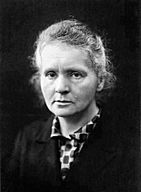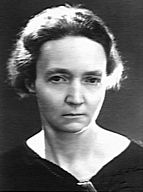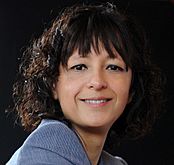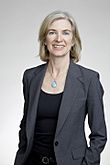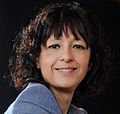Women in chemistry facts for kids
This article is about amazing women who have made big discoveries and important contributions in the world of chemistry. Chemistry is the study of what things are made of and how they change. These women have helped us understand everything from tiny atoms to how medicines work.
Template:TOC limit=3
Contents
Nobel Prize Winners in Chemistry
The Nobel Prize in Chemistry is a super important award given out every year since 1901. It celebrates people who have made the most important discoveries in chemistry. So far, eight women have won this amazing prize!
- 2022 – Carolyn R. Bertozzi – for creating special chemical reactions that work inside living things without messing them up.
- 2020 – Emmanuelle Charpentier and Jennifer Doudna – for inventing CRISPR gene editing, a tool to change DNA.
- 2018 – Frances Arnold – for using directed evolution to make enzymes (special proteins) better at their jobs.
- 2009 – Ada Yonath – for figuring out the structure and how ribosomes work. Ribosomes are like tiny factories in cells that make proteins.
- 1964 – Dorothy Hodgkin – for using X-rays to see the shapes of important molecules like penicillin and vitamin B12.
- 1935 – Irène Joliot-Curie – for discovering artificial radioactivity. This means making new radioactive elements in the lab.
- 1911 – Marie Curie – for finding the elements radium and polonium.
Marie Curie: A Pioneer in Chemistry
Marie Curie was the first woman ever to win a Nobel Prize in Chemistry in 1911. This was actually her second Nobel Prize! She also won the Nobel Prize in Physics in 1903. This makes her the only woman to win two Nobel Prizes in different science fields.
Marie Curie's chemistry prize was for her amazing work discovering the elements radium and polonium. She also figured out how to get pure radium and studied its special properties. Her discoveries changed how we understand matter and energy.
More Amazing Nobel Laureates
Irène Joliot-Curie, who was Marie Curie's daughter, became the second woman to win the Chemistry Nobel Prize in 1935. She won it for discovering artificial radioactivity. This was a huge step forward in nuclear chemistry.
Dorothy Hodgkin won the prize in 1964. She used a method called protein crystallography to find the exact shapes of complex molecules. Her work helped us understand how penicillin and vitamin B12 work in our bodies.
Forty-five years later, in 2009, Ada Yonath shared the prize. She studied the structure and function of the ribosome. Understanding ribosomes is key to knowing how cells make proteins, which are essential for life.
In 2020, Emmanuelle Charpentier and Jennifer Doudna made history. They were the first two women to share the Nobel Prize in Chemistry. They won for developing a method called "genome editing." This powerful tool allows scientists to change DNA with great precision. It has opened up new ways to treat diseases and understand life.
Women Chemists Around the World
Many other women have made incredible contributions to chemistry throughout history. Here are just a few of them.
Important Chemists of the 1800s
- Mary Watson (1856–1933): One of the first two female chemistry students at the University of Oxford in England.
- Margaret Seward (1864–1929): Also one of the first two female chemistry students at Oxford.
- Vera Bogdanovskaia (1868–1897): One of the first female chemists in Russia.
- Ida Freund (1863–1914): The first woman to become a university chemistry lecturer in the United Kingdom.
- Louise Hammarström (1849–1917): A Swedish mineral chemist and the first formally trained female Swedish chemist.
- Edith Humphrey (1875–1978): An inorganic chemist, likely the first British woman to earn a doctorate (Ph.D.) in chemistry.
- Julia Lermontova (1846–1919): A Russian chemist and the first Russian woman to get a doctorate in chemistry.
- Rachel Lloyd (1839–1900): The first American woman to earn a doctorate in chemistry. She was also the first regularly accepted female member of the American Chemical Society.
- Mary Engle Pennington (1872–1952): An American chemist who focused on food safety.
- Agnes Pockels (1862–1935): A German chemist who studied how liquids behave at their surfaces.
- Clara Immerwahr (1870–1915): The first woman to earn her doctorate in chemistry in Germany.
- Ellen Swallow Richards (1842–1911): An American industrial and environmental chemist. She was a pioneer in home economics.
- Fanny Rysan Mulford Hitchcock (1851–1936): One of the first women to earn a doctorate in philosophy of chemistry. She studied insects, fish bones, and plant diseases.
Key Chemists of the 1900s
- Alice Ball (1892–1916): An American chemist who developed an effective treatment for leprosy.
- Carolyn Bertozzi (born 1966): An American biochemist who won the Nobel Prize in 2022.
- Asima Chatterjee (1917–2006): An Indian organic chemist known for her work on plant-based medicines.
- Mildred Cohn (1913–2009): An American chemist who studied how enzymes work using special techniques.
- Gertrude B. Elion (1918–1999): An American biochemist who won a Nobel Prize for developing important drugs.
- Mary Peters Fieser (1909–1997): An American organic chemist who wrote many influential chemistry textbooks.
- Rosalind Franklin (1920–1957): A British physical chemist and crystallographer. Her work was crucial to understanding the structure of DNA.
- Helen Murray Free (1923–2021): An American chemist who helped develop simple dip-and-read tests for diabetes.
- Darleane C. Hoffman (born 1926): An American nuclear chemist who studies super-heavy elements.
- Allene Rosalind Jeanes (1906–1995): An American organic chemist who developed dextran, used in blood plasma.
- Isabella Karle (1921–2017): An American crystallographer who helped determine the structures of many biological molecules.
- Stephanie Kwolek (1923–2014): An American chemist who invented Kevlar, a super strong material used in bulletproof vests.
- Kathleen Lonsdale (1903–1971): A British crystallographer who studied the structure of crystals.
- Marie Marynard Daly (1921–2001): The first African American woman to earn her Ph.D. in chemistry in the United States.
- Alexandra Navrotsky (born 1943): An American geochemist who studies the energy of materials.
- Mildred Rebstock (1919–2011): An American pharmaceutical chemist who helped create an important antibiotic.
- Patsy Sherman (1930–2008): An American chemist who co-invented Scotchgard, a stain repellent.
- Susan Solomon (born 1956): An atmospheric chemist who studied the ozone layer.
- JoAnne Stubbe (born 1946): An American biochemist who studies how DNA is made and repaired.
- Ida Noddack Tacke (1896–1978): A German chemist and physicist who co-discovered the element rhenium.
- Margaret Thatcher (1925–2013): A British chemist who later became the Prime Minister of the United Kingdom.
- Karen Wetterhahn (1948–1997): An American metal toxicologist who studied how metals affect living things.
- Rosalyn Sussman Yalow (1921–2011): An American biochemist who won a Nobel Prize for developing a method to measure tiny amounts of substances in the body.
Leading Chemists of the 2000s
- Emily Balskus (born 1980): An American organic chemist and microbiologist who studies how bacteria make chemicals.
- Paula T. Hammond (born 1963): An American chemical engineer and professor at MIT, known for her work on new materials.
- Rachel Haurwitz (born 1985): An American biochemist and structural biologist who works with CRISPR gene editing.
- Katja Loos (born 1971): A German polymer chemist who works on making new plastics and materials.
- Sarah O'Connor: An American plant synthetic biologist who studies how plants make useful chemicals.
- Sarah E Reisman (born 1979): An American organic chemist who creates complex molecules in the lab.
- Marcey Lynn Waters: An American chemical biologist who studies how molecules interact with each other.
- Jenny Y Yang: An American chemist who researches clean energy solutions.
- Jaqueline Kiplinger: An American chemist who works at the Los Alamos National Laboratory, studying rare elements.
Images for kids
See also
 In Spanish: Mujeres en la química para niños
In Spanish: Mujeres en la química para niños


